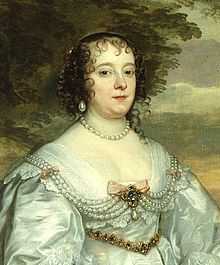Charlotte Stanley, Countess of Derby

Charlotte Stanley, Countess of Derby (1599–1664), born Charlotte de La Trémoille, is famous for her robust defence of Lathom House during the English Civil War.
Early life
Charlotte, born at the chateau of Thouars, Poitou, in France,[1] was the daughter of the French nobleman Claude de La Trémoille, Duke of Thouars, and his wife Charlotte Brabantina of Nassau. Her maternal grandparents were William the Silent and Charlotte de Bourbon.
On 26 June 1626, Charlotte married the English nobleman James Stanley, 7th Earl of Derby, who was taken prisoner at Nantwich in 1651, and was beheaded at Bolton.
English Civil War
Lady Derby was famous for her defence of Lathom House in the Siege of Lathom House by Parliamentary forces during the First English Civil War in 1644. During the absence of her spouse, she was left in charge of what turned out to be the last remaining Royalist stronghold in Lancashire. Immediately after the fall of Warrington, the Roundheads requested that the countess acknowledge Parliament's authority and surrender her house, but she refused on the grounds that doing so would dishonour her husband. She offered to limit herself to defending her home, and this postponed further attacks on her position. In February 1644, Latham House was sieged by the forces of Sir Thomas Fairfax. Lady Derby had fortified the castle to resist bombardment and assembled a militia of seasoned marksmen who were able to inflict significant losses by sniping, and she expressly denied repeated offers of surrender. On 27 May 1644, Prince Rupert arrived with royalist forces and the siege was broken. Lady Derby and her staff were evacuated to the Isle of Man.
Isle of Man
Her husband was also Lord of Mann, and Lady Derby's attempt to barter the Isle of Man for her husband's freedom provoked an anti-English revolt on the island led by Illiam Dhone.
Lady Derby was holding Man, but the total destruction of the Royal army at Worcester, the flight of Prince Charles to an exile in France, and the execution of her husband, left her without hope of assistance, she eventually yielded with reluctance to the necessity of a surrender, and retained,[2] says David Hume, "the glory of being the last person in the three kingdoms, and in all their dependent dominions, who submitted to the victorious rebels".[3][lower-alpha 1]
Family
Charlotte and Derby were parents of four daughters and five sons. Only four of their children appear to have survived to a marriageable age:
- Charles Stanley, 8th Earl of Derby (19 January 1628 – 21 December 1672).
- Lady Henriette Mary Stanley (17 November 1630 – 27 December 1685). Married William Wentworth, 2nd Earl of Strafford.
- Lady Amelia Ann Sophia Stanley. Married John Murray, 1st Marquess of Atholl.
- Lady Catherine Stanley. Married Henry Pierrepont, 1st Marquess of Dorchester.
Charles's two sons, William, the 9th Earl (c. 1655–1702), and James, the 10th (1664–1736), both died without sons, and consequently, when James died in February 1736, his titles and estates passed to Sir Edward Stanley (1689–1776), a descendant of the 1st Earl. From him the later Earls of Derby are descended.
Notes
- ↑ Not all historians agree with this assessment for example Jonathan Duncan postulated that Elizabeth Castle on Jersey may have surrendered later (Sir George Carteret the governor of the castle surrendered it on 15 December 1651).[4]
- ↑ http://www.knowsleyhallvenue.co.uk/Great-Women-of-the-Stanley-Family.pdf
- ↑
 One or more of the preceding sentences incorporates text from a publication now in the public domain: Lodge 1842, p. 137
One or more of the preceding sentences incorporates text from a publication now in the public domain: Lodge 1842, p. 137
- ↑ Hume 1822, p. 78.
- ↑ Duncan 1841, pp. 96–99.
References
- Draper, Peter (1864), "Charlotte de Tremouille", The House of Stanley; Including the Sieges of Lathom Hous, whith Notices of Relative and Co-temporary Incidents &c., Ormskirk: T. Hutton, pp. 242–246
- Duncan, Jonathan (1841), The History of Guernsey: With Occasional Notices of Jersey, Alderney, and Sark, and Biographical Sketches, Longman, Brown, Green, and Longmans, pp. 96–99
- Hume, David (1822), The History of England: From the Invasion of Julius Cæsar to the Revolution in 1688 4, E. Parker, p. 78, 489–490
- Lodge, Edmund (1842), The Genealogy of the Existing British Peerage: With Sketches of the Family Histories of the Nobility (8th ed.), Saunders, pp. 137
Further reading
- Kmec, Sonja (2010), Across the Channel, Noblewomen in Seventeenth-Century France and England, Trier (De): Kliomedia
 Wood, James, ed. (1907). "Derby, Charlotte Countess of". The Nuttall Encyclopædia. London and New York: Frederick Warne.
Wood, James, ed. (1907). "Derby, Charlotte Countess of". The Nuttall Encyclopædia. London and New York: Frederick Warne.
|